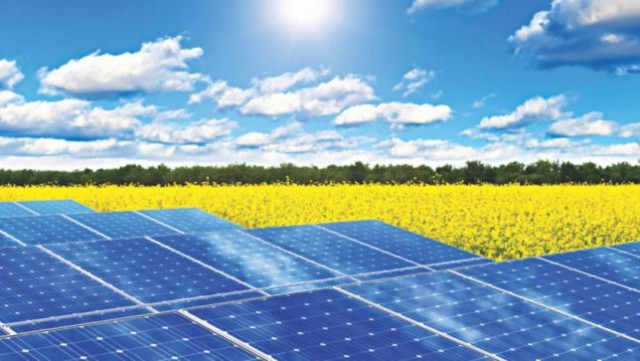NEWS The superior choice: Bangladesh and India should build solar farms, not coal plants, on both sides of the border
Dr Saleemul Huq and Daniel Kammen
For a pdf of this article, access the RAEL publications page link: or just click here.
Last week, Bangladesh’s Power Development Board (PDB) and India’s National Thermal Power Corporation (NTPC) announced that they will form a committee to decide whether to build a large coal plant or solar farm in India for additional power import into Bangladesh. Going by the numbers—economic, job creation and environmental—there really should be no debate. The choice is solar.
The facility will be run by the Bangladesh India Friendship Power Company, which was initially formed to build the controversial 1320MW coal-fired power plant near Rampal, Khulna. The fact that PDB and NTPC might seriously compare the costs and benefits of coal versus solar PV for the first time is good news for citizens of both countries.
Here are three undeniable reasons why solar farms are the superior choice to coal plants in both countries.
COST
Renewable energy costs in India have fallen by 50 percent in two years, and are forecast to continue dropping apace. New wind and solar is now 20 percent cheaper than existing coal-fired generation’s average wholesale power price, and 65 percent of India’s coal power generation is being sold at higher rates than new renewable energy bids in competitive power auctions. Bangladesh would save money in the short- and long-term by developing its own solar resources as well as by importing solar-generated electricity from India, and using its existing gas-fired power plants at night to back up solar power.
Our international team of researchers at the International Centre for Climate Change and Development and the University of California, Berkeley are about to publish groundbreaking maps of Bangladesh that indicate potential areas for solar and wind energy projects. After excluding all areas likely to be environmentally or socially unacceptable for such projects, we found that there is far more utility solar energy potential than previously estimated, at costs lower than new coal power.
In 2016, electricity demand in Bangladesh was 11.4GW, mostly coming from natural gas. The government of Bangladesh currently plans to develop 13.3GW of new thermal coal by 2021, and less than 2GW of solar farms. But Bangladesh could replace all 13.3GW of planned coal plants with solar farms at 20 percent lower costs than new coal plants.
Solar farms can be built much faster than coal plants, and battery storage isn’t needed as long as solar comprises less than 20 percent of the grid. Solar resources are free and deflationary, while coal is inflationary and subject to price hikes. Overall, solar PV is excellent financial news for electricity consumers and governments, and PV costs are expected to keep falling, in line with India’s experience.
FOOD
Our study makes clear that solar farms can supply 13.3GW of energy without converting large areas of precious agricultural lands. Solar plants can now be designed with space between the panels to allow for fish ponds or crop production, preventing impacts on food security and farmers.
HEALTH AND SAFETY
Choosing solar farms will avoid the widespread toxic contamination of air with sulfur dioxide, nitrogen oxides and particulates that come from even the best coal plants, sparing tens of thousands of Indians and Bangladeshis from premature deaths, low birthweight babies, heart attacks, respiratory disease, and cancer. Mercury spewed from coal plants falls on rice fields and wetlands, concentrating in rice grains as well as fish, crustaceans and shellfish. Pregnant women eating these contaminated foods have babies with birth defects and permanent brain damage.
Solar farms also avoid coal ash waste dumps that pollute downstream ecosystems like the Sundarbans mangroves, which protect millions of people in both countries from floods, storm surges, and cyclones. The proposed coal plant at Rampal alone is predicted to cause an additional 6,000 premature deaths as far away as Dhaka and Kolkata; low birth weight of 24,000 babies; and spew 10 tonnes of mercury into the air or water, threatening Sundarbans and Bay of Bengal fisheries.
Burning coal is the largest source of greenhouse gas, warming the ocean and melting sea ice at the poles. Low-lying Bangladesh is one of the most vulnerable countries on earth to the impacts of climate change. These effects on our climate cause deadly storms, floods, droughts, extreme heat waves, sea level rise, salinification, and desertification. Bangladesh has committed to 100 percent renewable energy by 2030 pending international support; and a five percent reduction of greenhouse gas emissions from the power, industry and transport sector by 2021. These global effects are important, but they pale in comparison to the local health impacts and the water costs alone.
Bangladesh and India can better meet their goals for sustainable electricity for all, sustainable development and climate justice by channelling investment into cheaper, well-planned solar farms than into coal-fired power plants.
For a pdf of this article, access the RAEL publications page link: or just click here.
Dr Saleemul Huq is Director, International Centre for Climate Change and Development, Independent University, Bangladesh. Professor Dan Kammen is Director, Renewable and Appropriate Energy Laboratory, University of California Berkeley, and until August 2017 served as Science Envoy for the US Secretary of State. Email: saleemul.huq@iied.org; kammen@berkeley.edu

You must be logged in to post a comment.